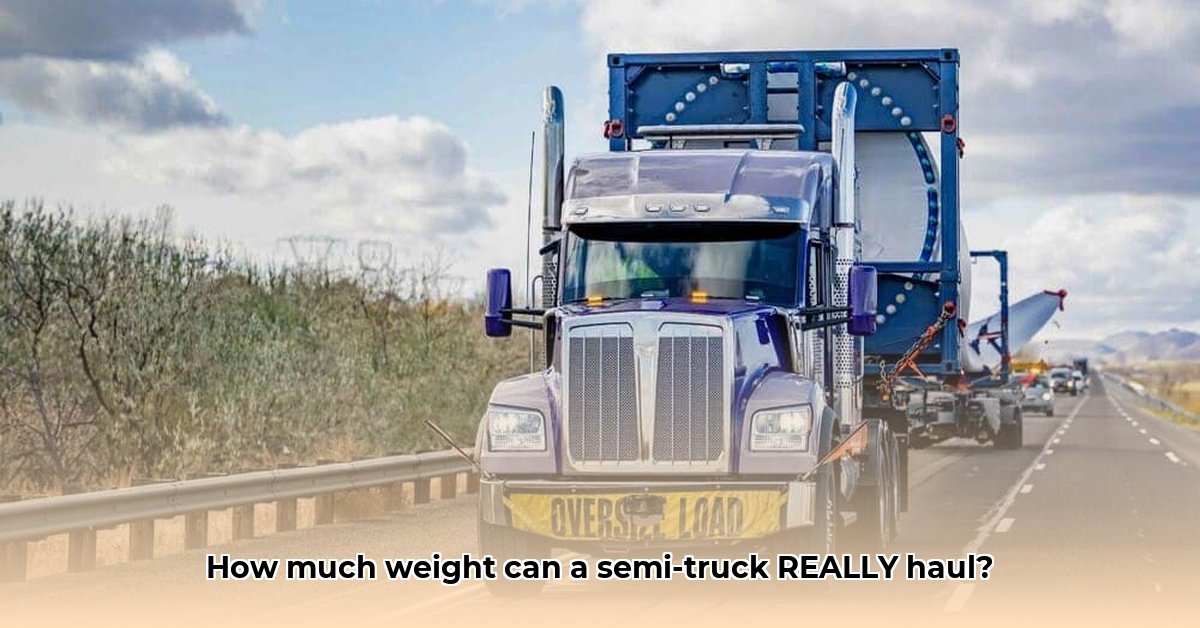
Understanding Weight Limits: Key Terms and Concepts
Determining the maximum weight a tractor-trailer can carry isn't straightforward. Several factors influence this, including the vehicle's specifications and the applicable regulations in your location. Let's start by clarifying some key terms:
Gross Vehicle Weight Rating (GVWR): This is the maximum permissible weight of a fully loaded tractor-trailer, as specified by the manufacturer. It includes the weight of the truck, trailer, cargo, and driver. (Think of it like the maximum weight capacity printed on a piece of luggage.)
Gross Axle Weight Rating (GAWR): This indicates the maximum weight allowed on each axle of the vehicle. Maintaining even weight distribution across all axles is crucial for safety and compliance. (Imagine a seesaw; overloading one end will cause it to tip.)
Legal Weight Limits: These are the maximum weights permitted by law in a specific region (country, state, or province). These limits often fall below the GVWR to ensure road safety and protect infrastructure. These limits can vary significantly based on road conditions and infrastructure capabilities. They also often differ based on the type and configuration of your tractor trailer.
For more detailed information, check out this helpful resource: Weight Limits Guide.
Did you know? Exceeding any of these weight limits can result in significant fines, delays, and potentially safety hazards. Precise weight management is paramount.
Regional Variations in Weight Limits: A Global Perspective
Weight limits for tractor-trailers vary considerably across the globe. What's legal in one country might be illegal in another. This is due to differences in road infrastructure standards, safety regulations, and environmental concerns.
For example, while the US may have a common limit around 80,000 pounds for certain configurations, European countries may have higher limits, potentially reaching 88,000 pounds or more under specific circumstances. Regional differences extend to Australia, where specific configurations can even exceed 100,000 pounds under very strict conditions. International shipping requires meticulous planning and adherence to local regulations to avoid costly penalties and shipping delays.
Quantifiable Fact: A study by the American Transportation Research Institute (ATRI) found that overweight trucks are significantly more likely to be involved in accidents.
Special Configurations and Their Weight Implications
Beyond the standard tractor-trailer, numerous configurations exist, each with its own weight limitations. These include:
- Spread Axles: Spacing axles further apart helps distribute weight more evenly, potentially allowing for higher total weight.
- Doubles and Triples: Using multiple trailers increases capacity but introduces more stringent regulations regarding length and weight.
These specialized setups often have specific legal requirements, sometimes requiring special permits even when falling within general weight constraints. Understanding these variations is essential for compliance.
Compliance Strategies: Maximizing Payload Safely and Legally
Successfully operating within weight limits requires a multi-faceted approach. Consider the following steps:
Regular Weigh-ins: Frequent weigh-ins using certified scales at weigh stations before and during long hauls are essential for detecting overweight conditions and preventing fines. (Aim for weigh-ins at the beginning, middle, and end of your most challenging routes.)
Strategic Load Planning: Properly distributing cargo is critical to ensure even weight distribution across all axles. (This is like balancing a seesaw.) Consider using load-planning software to optimize weight placement.
Leverage Technology: GPS tracking and telematics systems provide real-time weight monitoring, enhancing route planning and minimizing risk.
Driver Training: Thoroughly train drivers on weight regulations, load-planning procedures, and the consequences of non-compliance. A well-trained driver is an indispensable asset.
Maintain Detailed Records: Keep thorough records of all weigh-ins and related compliance efforts. This aids in dispute resolution and regulatory audits.
Expert Quote: "Proactive weight management is not just about avoiding fines—it's about ensuring the safety of your drivers, your equipment, and the public," says Dr. Sarah Chen, Transportation Safety Expert at the University of Michigan's Transportation Research Institute.
Legal and Regulatory Considerations: Penalties for Non-Compliance
Non-compliance with weight limits carries severe consequences. Fines vary by region but are typically substantial, and in severe cases can involve legal action, license suspension, and damage to reputation.
Staying informed of applicable regulations is crucial. Regularly reviewing your country's or state's transportation authority website should be standard practice to avoid non-compliance.
Common Weight Limits: A Regional Snapshot
Note: This is a simplified overview. Always refer to official sources for the precise and current legal weight limits in your specific location and for individual transport configurations.
| Region | Typical Maximum Weight (lbs) | Note |
|---|---|---|
| USA | Varies by state | State-specific regulations and configurations significantly affect limits. |
| Europe | Varies by country | Significant differences exist between countries and within countries themselves. |
| Australia | Varies greatly | Can significantly exceed 100,000 lbs under certain circumstances and conditions. |
This guide provides a general overview. Always check official sources for accurate and up-to-date regulations. Legal and safe operation requires diligent attention to detail and proactive compliance strategies.